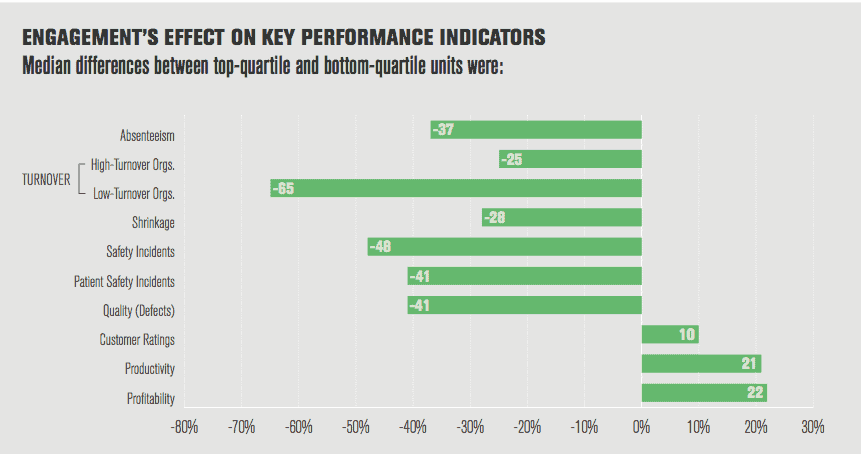Do you know your employee retention rate? If not, it's time for you to learn how to calculate this critical metric.
Ignoring retention issues can slowly kill your company, especially if the number suddenly drops sharply. Losing employees means not only losing valuable skills or talents, but also money; it costs a shocking amount in recruiting, hiring, and training to replace them.
Understanding your retention rate helps you recognize if you have a real problem or typical turnover for your industry. Knowing this, you can make the necessary changes to fix it before it damages your business too much.
In this post, we'll walk you step-by-step through how to accurately calculate your organization's retention rate. Then, we give you actionable tips to improve the rate, and help you understand why it may have become a problem at your company.
Table of contents:
- What is Employee Retention Rate?
- Why You Should Calculate and Care about Your Retention Rate
- How to Calculate Your Retention Rate of Employees
- Proven Ways to Improve Your Retention Rates
- Closing thoughts and advice on Employee Retention
Let's start by looking at exactly what retention rate means and why you should pay close attention to it.
What is an Employee Retention Rate?
First things first, let’s briefly define what your employee retention rate is.
Employee retention rate measures how well your company is retaining its employees. When you calculate the employee retention rate, you get a percentage of people who remain in your company for a specific period. Usually, it’s calculated monthly, quarterly, or annually.
Some people think that it’s the same as employee turnover rate, but in reality, it is the opposite. The turnover rate measures how many employees leave your company in a given period, while retention rate is about how many stay. They’re different metrics, but are caused by the same reasons.
Keep in mind that both of them are not just some numbers on your dashboard. They help you understand how well you are succeeding in creating a great workplace culture and managing people. They are a real measure of how your employees feel about working at your company.
What do your numbers say about your company?
Why you Should Calculate and Take Care of Your Retention Rate
Your employee retention rate is a barometer for how your company is doing. You should treat it as a sign of a job well done, or a serious sign of trouble brewing that you need to address.
When your retention rate is high, it means your employees like working at your company. They feel fulfilled and don’t want to go to the trouble of searching for a job somewhere else.
Meanwhile, if your rate starts to drop, that is a sign your employees are voting with their feet; they’ve decided they’d rather work somewhere else. Unless you make changes you’ll have more and more people looking for the exit.
The costs of employees you fail to retain can add up fast.
Losing employees is extremely expensive! The Society for Human Resource Management found that it costs an average of 6-9 months of your former employee's salary to find and onboard their replacement. And that cost is just for a single lost team member
Can you imagine how quickly those replacement costs add up if you're losing a wave of team members?
All that said, money is just one of the downsides of low retention rates.
High turnover also kills the productivity of your company because you constantly have to train new hires. Plus, your team's morale and performance suffer when you lose valued members. People have friends they’ll miss, and everyone tires of training new hires if it keeps happening (“what’s the point of onboarding someone who is just going to quit!??”).
Here are some additional costs associated with low retention rates you may not have considered:
- Lost productivity as positions stay vacant. When an employee leaves, there is still work that needs to be done. Their projects and responsibilities don't disappear. Hubspot estimates this productivity drain costs businesses $1.8 trillion per year across the US. For key roles like executives, the impact is even greater.
- Costly advertising and recruiter fees to source new candidates. According to our calculations in a prior post, it could cost you over $25,000 simply to source candidates that eventually lead to a single hire.
- Screening resumes and conducting interviews takes a lot of your time. Filtering through resumes, holding phone screens, and hosting in-person interviews can cost a great deal in lost productivity for you and every team member involved.
- New employees take months to reach full productivity. Someone who has been doing a job for years is going to be a lot better and faster at doing that job than someone brand new. It takes months to ramp up, which you also need to add as a hidden cost.
When you add all that up, you can see that turnover really hurts your bottom line. If you’re not careful, it can drag down your whole business without you even recognizing the problem. That’s why monitoring your retention metrics has to be a priority.
Otherwise, it can get quite bad before you do anything about it, and then it will be a lot harder to fix.
With that in mind, let’s look at how you can calculate this number.

How to Calculate Your Retention Rate of Employees
Calculating your retention rate is quite easy — you just need two key figures:
- Number of employees at the start of the period
- Number of employees who remain at the end of the period
Here’s what a retention rate formula looks like:
Retention Rate = (Number of employees retained / Number of employees at start of period) x 100
Let's walk through a few examples to see how it works.
Examples of Calculating Retention Rate
| Monthly Retention Rate | Quarterly Retention Rate | Annual Retention Rate |
|---|---|---|
| — Start of month: 30 employees — End of month: 24 employees — Retention Rate = (24 / 30) x 100 = 80% | — Start of quarter: 150 employees — End of quarter: 130 employees — Retention Rate = (130 / 150) x 100 = 86.7% | — Start of year: 500 employees — End of year: 450 employees — Retention Rate = (450 / 500) x 100 = 90% |
As you can see, even losing a few employees each month can significantly impact your overall retention rate.
It's important to note that when calculating your retention rate, you should not count any new hires that joined your company during the time period. For example, if you had 30 employees at the start of the month, hired 10 new people, but lost 6 employees, your retention rate should be based on the 30 initial employees, not the net growth to 34 people. The 6 employees who left represent hidden turnover that could be masked if new hires are included in the calculation.
Many companies, especially those experiencing hyper growth, make the mistake of counting new hires, failing to realize how many people they are actually losing.
Don’t make that mistake.
It can be very costly to then only recognize a retention issue once you can’t hire fast enough to keep up with so many people leaving. That’s where I’ve personally seen companies turn out to have retention rates as low as the 60-70% range once they calculate it properly.
Retention Rate Calculator
You can use our free retention rate calculator to make things super easy for you to measure it right now. Remember to exclude any new hires that would hide your real turnover rate:
What is considered a low retention rate?
Now that you know the retention rate formula, used our calculator, and know your employee retention rate, the question becomes, “How do I know if my number is good or bad?”
Luckily, Praisido has a benchmark of the turnover rates across different industries for the year 2022, which we also show you the equivalent retention rate for below:
- Advertising — 7.66% (Turnover Rate) = 92.34% (Retention Rate)
- Clothing and Apparel — 6.47% = 93.53%
- Commerce and Shopping — 9.46% = 90.54%
- Design — 6.74% = 93.53%
- Education — 8.34% = 91.66%
- Sales and Marketing —12.54% = 87.46%
- Artificial Intelligence — 16.90% = 83.1%
- Software — 15.35% = 84.65%
If you’re worse than the number listed for your industry above (or at the link we provided), that’s a sign you have work to do.
There might be several reasons why you’re below average, so to get you started, here’s some further reading that will help you understand why people are leaving your company or team.
Further reading:
- 14 Reasons Why Great Employees Quit Your Team
- How Managers Can Cause Low Employee Morale
- “Why Are My Employees Quitting?”: 5 Ways To Stop An Employee Turnover Wave
Proven Ways to Improve Your Retention Rates
Now that we know how expensive and damaging employee turnover is, the question becomes: what can you do to keep your great employees around longer?
Here are three strategies that will help you:
Be a Good Manager
A common phrase that rings true is that, “people leave managers, not companies.”
Long time readers of our blog know that there’s a ton of data out there to support this idea. For example, workplace research leaders Gallup found that, "The manager accounts for at least 70% of the variance in employee engagement."

That’s really important, because engaged employees have much lower turnover in addition to a variety of other benefits like increased productivity, and profitability. So not only can you and your managers prevent turnover problems, but you can also improve the team that you are convincing to stick around.
Now, this does beg the question: How can you keep your team members engaged? Here’s a few ideas:
- Hold regular 1-on-1 meetings to open communication channels and understand any issues early. Don't just go through status updates — dig into their problems proactively before they escalate to the point of quitting.
- Make employee growth a priority through training, mentorship, and making clear career paths. You should invest time in understanding your team's goals and providing opportunities tailored to them.
- Provide consistent feedback and praise to recognize great work. Employees want regular check-ins on how they're doing, not just an annual review. Specific, timely praise is highly motivating, too.
- Lead by example to set the tone in your workplace. Bring positive energy, take ownership of mistakes, and model the work ethic you want to see. Your attitude permeates your team. Just try not to just don't overdo it with positivity, as it can become toxic and start damaging your culture.
We’ve barely scratched the surface with these tips. There’s a lot more you can learn about being a great manager, so here’s some further reading to help you go deeper on the subject:
- Why People Leave Managers Not Companies
- What is Servant Leadership and How it can help you
- Good Manager Vs Bad Manager: How A Good Manager Is Worth $192,375 More
- 5 Best Practices to Respond to Employee Resignation

Give Them Meaningful Work
You want your team to be fully invested in their roles, not just going through the motions.
One of the best ways to get your team engaged more, and loving their job long term, is to help them understand how their work contributes to something bigger than themselves.
Research shows that purpose is a massive motivator.
For example, Daniel Pink wrote about one interesting experiment at a university fundraising call center. Employees were split into three groups:
- Group 1— read stories about the personal benefits of the job
- Group 2 — read stories of how their fundraising impacted beneficiaries
- Group 3 — read nothing
The group that learned how their work helped real people raised more than twice as much money as the other groups! The purpose behind their work inspired them.
There was another study that showed the importance of giving purpose to work even for what is often considered undesirable work.
A study of Hospital janitors found that those who saw their role as creating sterile environments to improve patient healing were much more engaged and satisfied than those who just saw themselves as custodial workers.
Some employees said "I'm a healer. I create sterile spaces in the hospital. My role here is to do everything I can to promote the healing of the patients."
As you see, reframing any role to focus on its purpose — no matter how small — makes a big difference.
Take time to explain how every role on your team contributes to your company's mission and helping your customers. Employees want to know their work matters, but can sometimes forget or be too far removed from the results to see it on their own.
One of the easiest ways to inject more purpose into people’s work is to mention it while you’re praising someone. Thanking someone for playing a key part in creating a product that solved a key customer problem, or saved the day when a key client had an issue is much more powerful than a generic "good job." You can also pass along any gratitude from a customer so they hear it straight from the source.

Don't Tolerate Toxic Employees
Another key tactic is a bit different than our other recommendations. This one is about how one employee may hurt others on your team.
Have you ever worked with someone who was just a total jerk? Assuming you have, you know how much life it takes out of you and your fellow team members. Their bad attitude spreads like a virus and destroys great workplace culture and poisons what can otherwise be a great team dynamic.
In his book, The No Asshole Rule, Robert Sutton shared a study from the UK, where researchers found that “25% of bullied victims and 20% of witnesses quit their jobs”.
That’s important to recognize because not only are the people taking the brunt of the abuse considering leaving, but a similar amount of those simply nearby are turned off enough by the behavior to leave, too. Don’t think that because conflict with a jerk is only directly between a couple people that you’ve isolated it; you’re hurting everyone in eye or earshot.
Reinforcing this, research published by Harvard Business School calculated the hidden costs that come with keeping toxic employees and jerks.
They found that even if a top performing asshole could be replaced by an average performer, it would still be better financially to replace him by more than two-to-one. This means that top performers who are jerks actually cost more than they deliver due to their toxic impact on others. This is unsurprising, as their behavior damages the morale, energy, and work of the entire team, but you probably never did the math.
If you think you have an asshole on your team, for the sake of retaining everyone else on your team, you must find the courage to address the issues or remove them. No matter how good they may seem to perform, you and your team will be better off without them.
Want to dive deeper into the damage jerks can cause and how to deal with them? We've written a post exploring how managers themselves can accidentally kill team morale through ineffective leadership. Check out our guide on How Managers Can Cause Low Employee Morale.
And if you want to try to improve a toxic employee, try our battle-tested tactics to turn around employees here.
Closing thoughts and advice on Employee Retention
Retaining top talent is crucial, but also challenging. Employees have more options than ever, and it’s never been easier to seek out and find a new job.
You have to work hard to create an engaging environment where your people want to stay.
To accomplish this, you need to hire managers and be the kind of manager that cares about their people. Make sure each role provides meaning and purpose. And don't tolerate toxicity that poisons morale.
No company is perfect, but strive to listen to your employees and address issues quickly. Even small frustrations can boil over if left unresolved.
Your team deserves your best, because they are what makes your company succeed. Keep retention top of mind as you build your organization and culture. It’s a warning sign of bigger problems that can sink an otherwise promising company.
The strategies we covered today are proven to help. But even more important is making retention a priority and genuine passion. Do that, and your employees will repay you many times over.





